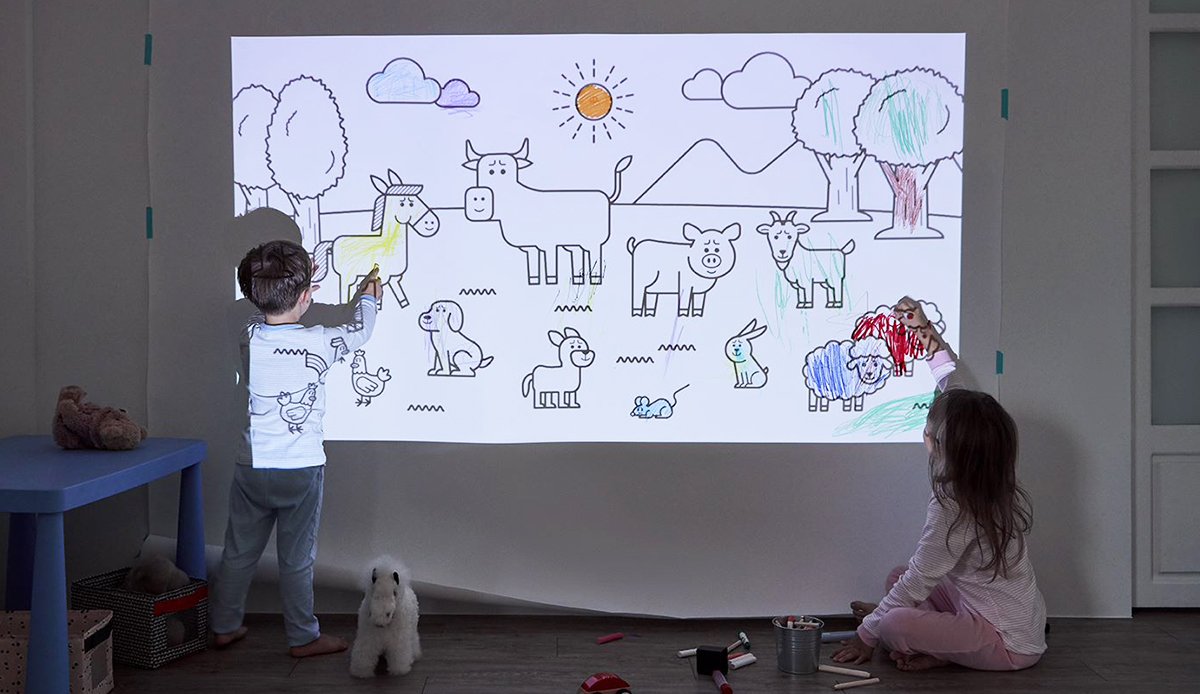Are you an artist looking for the best projectors to showcase your creative vision? You’ve come to the right place!
This guide provides an in-depth look at the various projectors available for you so you can create stunning visuals to dazzle your audience.
Projectors are becoming increasingly popular in the artistic community, especially among graphic designers and photographers. Projectors can be used to view images, videos, and other artwork on a larger screen. Today’s projectors range from pocket-sized models to large models for use on a motion picture set.
The purpose of this guide is to provide the information you need to choose the projector that meets your needs. We will discuss the features to look for when choosing a projector, various types of projectors available and their applications, as well as important safety considerations.
At the end of this guide, you should have an understanding of what projector will allow you to create your vision with quality and ease. You’ll also have some ideas about how different types of projectors can be used in creative projects. So let’s get started!
Explanation of the topic and its relevance to artists
Artists around the world have embraced the use of projectors in their creative works. Projectors add a new depth to artwork and can be used for a variety of projects. Whether you’re an aspiring artist, a professional photographer or even a student looking to make an impression at school, projectors can help bring your work to life.
Projectors come in many shapes and sizes, but they all serve the same purpose: projecting images onto flat surfaces. This unique feature enables artists to create visuals that wouldn’t be possible through traditional methods. With projectors, you can create murals, logos and images on walls, ceilings or other large spaces with ease. They also allow for more detailed work on intricate products like boxes, jewelry or masks with complex patterns.
Aside from their artistic applications, projectors are also useful for cost-effective marketing campaigns as well as seamless presentations during conferences and seminars. Artists today have access to a range of technologies that can help them showcase their projects and present them in far greater detail than ever before—and projectors are one of those technologies. Thus it is important for artists to understand what they need to know when selecting the right projector for their needs. By mastering the basics such as types of projectors, picture resolutions needed and other usabilities like wireless presentation tools, an artist can fully explore their creativity with this amazing technology available today.

Benefits of using projectors for art projects
Using projectors in art projects has many advantages. Projectors allow an artist to get a better understanding of scale and depth. It also allows them to gain experience with three dimensional working and make use of projection mapping techniques to animate entire works, making the art more interactive and engaging for viewers. The use of projectors can also create amazing illusions that would be difficult or impossible to achieve otherwise.
When developing a piece with a projector, you will be able to move at a much faster pace than if you were hand painting or drawing something from scratch. Large pieces of art become much easier because the artist can draw on top of what is being projected onto a wall or canvas directly in real-time, reducing production time significantly. This is especially beneficial for those who are looking to create mural size pieces quickly as well as those who need tight timelines for commercial projects. Lastly, projectors can help remove guesswork and make it easier for artists to avoid errors when developing their prints or artwork by giving them the capability to see their progress in real-time without having to stop the process and re-evaluate what they have created.
Enhanced accuracy and efficiency in transferring sketches to larger surfaces
Projectors provide improved accuracy and efficiency in transferring sketches to larger surfaces, as opposed to placing a sketchbook against the wall or using a lightbox. Projects can easily be transferred onto canvas, walls, or any other large surface at a much higher level of detail than would be possible without the projector. With practice, users can become very rapid and accurate in their use of the projector for transfers.
Creative artists can save time by using the latest technology projectors to transfer sketches to larger surfaces with increased precision and accuracy while saving time and money Overall Projectors are applicable across many industries including production of movies, advertisement projections as well as art work. Many artists use them for more detailed drawings on canvases or walls. It is also common for architects to rely on projectors for scaled-down models for construction purposes.
Projector technology has advanced significantly over the years and now supports easy aligning and resizing capabilities with enhanced accuracy which makes them perfect for creative projects where precision is important. In addition, modern projectors allow users to magnify images from small areas such as pencil sketches up onto larger surfaces with convenience and efficiency so you don’t have to depend on tracing paper or light boxes anymore. Artists should take advantage of this technology by investing in long-lasting projector devices that won’t break down or degrade quality during transfer processes while having control over size/color calibration settings suitable according to one’s need.
Ability to experiment with different compositions without committing to permanent marks
Using a projector for art allows you to quickly and easily experiment with different compositions before committing to any final marks or pieces. When working with traditional media, if an artist makes a mistake, it can be hard to cover up or start over. With a projector, you can get the basics of your piece down without making any permanent marks that you can’t undo. This allows you to explore and make changes without the worry of having to completely redo your work.
Projectors also allow artists to keep working as they develop ideas on the spot. Instead of trying to imagine what an artwork may look like in specific color muted tones or experimenting with composition on a blank surface while sketching out ideas in pen, a projector gives an artist confidence that the picture they paint will look right when transferred onto canvas or paper later on. This gives artists more time for exploration and discovery during the creative process rather than being tied up in details such as worrying about getting exact lines down correctly from the first go around.
Additionally, by projecting designs onto surfaces such as walls make them easier for artists to plan their works more carefully and systemically. Instead of being limited by small spaces like those found on paper, where lines become cramped within relatively short spaces with very little room for movement and expression, projections enable artists more space when planning works that are composed out of larger parts (i.e mural painting) since walls have countless possibilities for rearranging parts until it looks optimal. Therefore maximizes your canvas potential as far as concept design goes!
Factors to consider when choosing a projector
Choosing the right projector for your needs can be overwhelming. To make the best decision, there are several factors to consider. The type of projector, resolution, aspect ratio, lumens, and connectivity are all important considerations in finding a projector that suits your needs.
Type of Projector: There are three main types of projectors available: DLP (Digital Light Processing), LCD (Liquid Crystal Display), and LED (Light Emitting Diode). DLP projectors use rotating color wheels and high refresh rates for sharper images without ghosting. LCD projectors capture light from small mirrors bouncing off a panel of liquid crystal cells to create an image on the screen. LED projectors have LED bulbs that emit light at lower voltages than traditional bulbs for better visibility when projecting onto large screens.
Resolution: Resolution is meant to describe how fine the details can be seen in a projected image. The higher the resolution, the greater the number of pixels that compose an image; this results in sharper images with more detail on a larger scale. When choosing a resolution size for your projector, it’s important to consider both how big you need it to be and how detailed you want your final product to look before deciding which is best suited for you.
Aspect Ratio: Aspect ratio determines the shape of an image projected from your projector and can either be 4:3 or 16:9 depending on the video format being used (4:3 is more common with older TVs whereas 16:9 is more common with HDTVs). Be sure to choose a projector that supports whatever aspect ratio you plan on using; this will help ensure optimal viewing experience when sharing or displaying works with others.
Resolution and image quality
The ability to display your creative projects in the best light may be reliant on the projector you choose. Resolution refers to the number of pixels that make up an image, with a higher pixel count meaning a sharper, higher detailed image. 720p is standard for smaller projectors, while 1080p models are better quality and you should aim for 4K if budget allows. Supported resolution will depend on compatibility between devices, while other factors such as aspect ratio (16:9/4:3) will also be important. It’s worth exploring features like keystoning to ensure your set-up gives you the best image possible, as well as auto-scaling which can make sure all of your content is shown at its optimum resolution.
It’s advisable not just to consider resolution but also the color accuracy of your projector – color brightness determines how vivid and clear an image looks while white brightness will determine how large a screen size you can have without compromising picture quality. Model specs should outline these details and there are some ways to test out displays before purchasing. Lastly, contrast ratio is another important factor – from standard to high dynamic range (HDR) it influences how much detail is captured onscreen and helps in producing richer blacks and whites that give astonishing depth and clarity when viewed side by side with lower contrast ratios.
Brightness and contrast
The brightness and contrast you choose for your projector are important for the overall look and feel of what you’re displaying. It’s typically measured in lumens and expressed as a ratio of how much light is projected compared to how much the images appear to be on the screen (contrast).
Brightness is important in a space with bright overhead lighting or when you want very saturated colors. When you need sharp details, high resolution, or deep-black levels, then contrast becomes more important. Darker walls make it easier to see the image better as they absorb surrounding light and minimize reflection of other colors that can interfere with image quality.
You’ll want to keep in mind the distances at which your audience will be viewing your work when considering brightness. For example, if your audience has low ambient light around them, a 2200 – 2600 lumens projector may suffice rather than going up to 4500 lumens. The ideal environment is one in which there is little ambient light and deep black levels offer the picture greater richness and depth. However, if there is some ambient room lighting it’s best to get a brighter projector so your visuals still shine through—they should still look equal or better what can be seen in natural daylight conditions.
It’s also recommended to adjust your projector settings according to aspect ratio requirements, display size limitations and other factors before finally dialing in color accuracy settings, so that you are able view exact color representations that accurately supplement details from other elements within your artwork before sharing them with audiences.
Portability and ease of use
When choosing a projector for your creative projects, portability and ease of use should be a top priority. Whether you’re creating art on the go or just need something that you can pack up quickly and easily, you want to be sure that the projector is straightforward and easy to set up. Ideally, you should also look for one that comes with its own accessories—like mounts, cables, and adaptors—so that everything can be connected quickly.
The size of the projector should also be taken into consideration – you don’t want one that’s too bulky to transport or too large to fit in your creative space. Most projectors are designed considering portability in mind but make sure to check before making your purchase!
You may also want to invest in wireless projectors as these are especially convenient if you plan to move around frequently or work in less traditional spaces. This type of projector is usually bigger than standard versions but has better portability due to not having cables connected at every end.
Last but not least, always make sure your chosen device has enough brightness level – most suitable range is between 2000 and 4000 lumens -to ensure perfect visibility even during daylight and avoid shadows on your art creation!
Conclusion
Projectors can be an invaluable tool for helping artists bring their creations to life. Whether you want to create immersive environments in interactive art pieces, show your work on an oversized canvas and scale, or animate illustration with crisp detail, choosing the right projector is important.
Projectors come in a variety of sizes, resolutions, input types and capabilities that take into account professional or home usage. When selecting a projector for your creative project, consider sunlight conditions and viewing distance when deciding on lumens; laser projection technology adds brightness and is ideal for bright conditions; HDMI and USB input types allow you to display your work from multiple sources; 3LCD technology ensures color accuracy; 1080p resolution creates cinematic clarity; and high refresh rates eliminate banding.
Professionals may benefit from higher-end features like lens shift capability or interchangeable lenses. Consider these factors when selecting the best projector for your managed visual content needs!
FAQs
Which projectors do artists use?
Artists use projectors that are designed for art projection, such as LED and digital projectors, which provide better color accuracy and image quality.
What is an artist projector?
An artist projector is a type of projector that is specifically designed for art projection. It is lightweight, portable, and provides high-quality images with accurate color reproduction.
What is the best projector for art projection?
The best projector for art projection is one that provides high image quality, accurate color reproduction, and has adjustable brightness and contrast levels. Some recommended models include the Artograph Flare150, Epson PowerLite Home Cinema 2040, and Optoma ML750ST.
Can you use a projector to trace art?
Yes, you can use a projector to trace art by projecting an image onto a surface and tracing it with a pencil or pen.
What are the three main types of projectors?
The three main types of projectors are DLP (Digital Light Processing), LCD (Liquid Crystal Display), and LCoS (Liquid Crystal on Silicon).
Which are the four types of projectors?
The four types of projectors are home theater projectors, business projectors, portable projectors, and gaming projectors.
How do artists use projectors?
Artists use projectors for a variety of purposes, such as enlarging and tracing sketches onto canvas or paper, projecting images onto walls for murals, or creating digital art installations.
What is the difference between projection and projector?
Projection refers to the process of displaying an image onto a surface using a light source, while a projector is the device that generates the light source and projects the image.
How do digital art projectors work?
Digital art projectors work by using an LED or LCD light source to project an image onto a surface. They are designed to provide accurate color reproduction and image quality, making them ideal for art projection.
How to make a projector for art?
To make a projector for art, you can use a simple lens and a bright light source, such as an LED bulb. You can also use a smartphone or tablet with a projection app to create a DIY projector for art.
See Also:
- Best projectors for sports
- Best soundbars for projectors
- Best projectors under $500
- Best projectors for home theater under 1000
- Best projectors under $300


